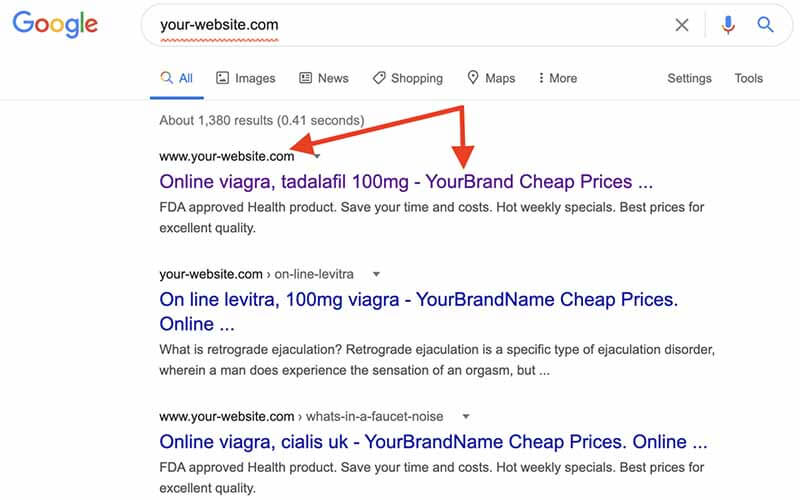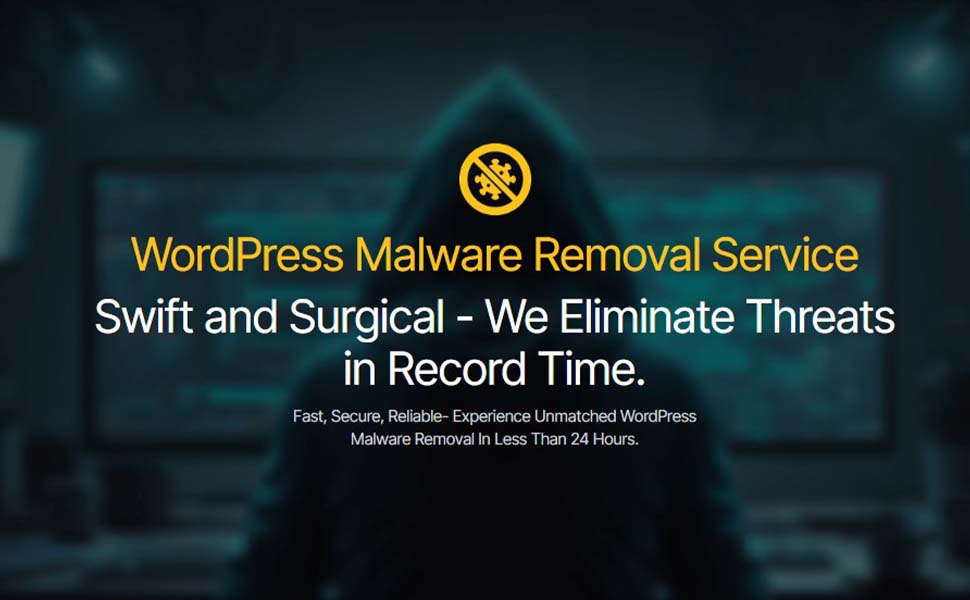Your website unexpectedly shows ads for prescription drugs like Viagra, but you didn’t put them there. That’s a clear sign of hacking, right? But what about the WordPress Pharma Hack? It’s sneakier. You might not even know it’s happening because it operates quietly in the background, silently infecting your website without you realizing it. In this regard, the question arises – what is WordPress pharma hack? Well, don’t worry. We are going to discuss all about the pharma hack, what it is, how it works, how to remove it, and the post steps after removing the malware. Then let’s begin with its definition.
What is WordPress Pharma Hack?

The Pharma Hack is a type of cyber attack that targets websites, particularly those built on WordPress, to inject malicious code promoting pharmaceutical products such as Viagra. This code alters the site’s content, often adding spammy links or advertisements without the website owner’s knowledge or consent.
Imagine you have a website where you sell clothes online. Suddenly, visitors start seeing ads for Viagra or other prescription drugs on your site, even though you never added them. That’s a pharma hack in action. It’s like someone sneaking into your store and putting up their own signs to sell something completely unrelated to what you offer.
Why does WordPress Pharma Hack Happen?
The WordPress Pharma Hack typically occurs when hackers exploit vulnerabilities in outdated WordPress themes, plugins, or weak passwords. They gain unauthorized access to the website and inject malicious code into its files or database. This code is designed to manipulate search engine results, promote pharmaceutical products, and generate revenue for the hackers.
The motive behind the WordPress Pharma Hack is usually financial gain. By promoting pharmaceutical products, hackers can earn commissions from sales or drive traffic to their own websites, where they may engage in further malicious activities or scams. Additionally, the hacked websites may be used to distribute malware or collect sensitive information from unsuspecting visitors.
How to Know if Your Site is Infected?

Detecting a pharma hack on your website requires vigilance and attention to certain indicators. Here are some signs that your site may be infected with a pharma hack:
Unwanted Pharmaceutical Content:
If you notice unauthorized ads or links promoting pharmaceutical products, especially related to Viagra or similar medications, appearing on your website, it could be a sign of a pharma hack.
Sudden Traffic Changes:
A significant increase or decrease in website traffic, especially from search engines, can indicate that your site has been compromised. Hackers often manipulate search engine rankings to promote pharmaceutical products, resulting in fluctuations in traffic patterns.
Search Engine Warnings:
If your website is flagged by search engines for suspicious content or malware, it may be a sign of a pharma hack. Check Google Search Console or other webmaster tools for any security alerts or manual actions related to your site.
Unexpected Redirects:
Users may be redirected from your website to unrelated or spammy websites without their consent. If visitors report unexpected redirects or you notice unusual redirection behavior on your site, it could be a symptom of a pharma hack.
Changes in Site Performance:
A pharma hack can impact your website’s performance, causing it to load slowly or display error messages. Monitor your site regularly for any performance issues that may arise suddenly and without explanation.
If you suspect that your website is infected with a pharma hack, it’s essential to take immediate action to remove the malicious code and secure your site. Utilize security plugins, conduct thorough scans, and consider seeking assistance from cybersecurity professionals to mitigate the impact of the hack and prevent future incidents.
How Harmful Is Pharma Hack WordPress?

If your site is pharma hacked, what could be the impact of the pharma hack on WordPress? We know, it is very essential to prevent the recurrence of the Google Viagra Hack becuase the impact could be fatal. So, knowing how to remove the pharma hack on wordpress would help you immensely.
However, the WordPress Pharma Hack can be highly damaging to a website and its reputation. Here are some ways it can be harmful:
Loss of Trust:
When visitors encounter unauthorized pharmaceutical ads or links on a website, it erodes trust in the site’s integrity. Users may question the legitimacy and safety of the website’s content, leading to a loss of credibility and potential loss of business.
Negative Impact on SEO:
The manipulation of search engine results by the pharma hack can result in penalties from search engines like Google. This can lead to a drop in search rankings, reduced visibility in search results, and loss of organic traffic.
Compromised Security:
The presence of malicious code injected into a website opens up vulnerabilities that can be exploited for further cyber attacks. Hackers may use the compromised site to distribute malware, steal sensitive information from visitors, or engage in other illicit activities.
Legal Consequences:
Websites promoting unauthorized pharmaceutical products may be in violation of various laws and regulations, leading to potential legal consequences, fines, or legal action.
Overall, the WordPress Pharma Hack poses significant risks to website owners, including reputational damage, loss of traffic and revenue, compromised security, and potential legal repercussions. Prompt detection and mitigation of the hack are crucial to minimize its impact and protect the website and its visitors.
How To Fix WordPress Pharma Hack?
In the quest to clean up a pharma hack from your WordPress site, understanding the steps to tackle the clean wordpress pharma hack is crucial. By addressing the pharma hack wordpress effectively, you can restore your website’s security and reputation, ensuring a safer online experience for your visitors. Taking prompt action and knowing how to remove the pharma hack on wordpress is important. Let’s now learn how to clean up a pharma hack if your site is already attacked.
Scan Your Website:
Utilize reputable security plugins or online scanning services to thoroughly scan your WordPress site. These tools are designed to detect malicious code, unauthorized changes, and potential vulnerabilities that may indicate a pharma hack. Running a comprehensive scan is the first step in identifying and assessing the extent of the infection.
Identify Infected Files:
Once the scan is complete, carefully review the scan results to identify the files, directories, and database entries affected by the pharma hack. Common areas of infection include theme files, plugin files, core WordPress files, and database entries such as posts, pages, and comments. Pay close attention to any suspicious or unfamiliar code, ads, links, or scripts injected into your website’s files or database.
Remove Malicious Code:
You need to restore the pharma hack wordpress database. After identifying the infected files, take immediate action to remove the malicious code and restore your website to a clean state. This may involve manually editing infected files to remove unauthorized ads, links, or scripts, or using security plugins to automate the cleanup process. Be thorough in your removal efforts to ensure that all traces of the pharma hack are eradicated from your website.
Update WordPress and Plugins:
Keep your WordPress core, themes, and plugins up to date to minimize the risk of future infections. Outdated software is more vulnerable to security exploits and may serve as a gateway for hackers to compromise your website. Regularly check for updates and apply them promptly to patch security vulnerabilities and strengthen your website’s defenses against malware and other cyber threats.
Change Passwords:
Change all passwords associated with your WordPress site, including admin accounts, FTP credentials, database access, and hosting control panels. Use strong, unique passwords that are difficult to guess or brute-force to prevent unauthorized access to your website. Consider implementing password management best practices, such as using password managers and enabling two-factor authentication, to enhance the security of your login credentials.
Implement Security Measures:
Enhance your website’s security posture by implementing additional security measures to protect against future attacks. This may include installing security plugins that offer features such as firewall protection, malware scanning, file integrity monitoring, and security hardening. Configure these plugins to proactively monitor your website for suspicious activity and block malicious traffic in real-time. Additionally, consider implementing web application firewalls (WAFs), content security policies (CSPs), and regular security audits to further fortify your website’s defenses against cyber threats.
Monitor Regularly:
Continuously monitor your website for any signs of suspicious activity or potential security threats. Set up automated security alerts or notifications to alert you of any unauthorized changes, malware detections, or other security incidents in real-time. Regularly review your website’s access logs, error logs, and security logs for any anomalous behavior or unauthorized access attempts. Perform regular security audits and scans to identify and address any security vulnerabilities before they can be exploited by hackers.
Request Malware Review:
If your website was flagged by search engines for hosting malware or engaging in malicious activity, take immediate action to clean up your website and request a malware review through Google Search Console or other webmaster tools. Once you’ve successfully removed the pharma hack and resolved any security issues, submit a review request to have the warning removed and restore your website’s reputation in search engine results.
By following these detailed steps and implementing proactive security measures, you can effectively remove the WordPress Pharma Hack from your website, mitigate the risk of future infections, and maintain a secure online presence for yourself and your visitors.
Remember to stay vigilant, stay informed about emerging threats, and regularly update and monitor your website’s security posture to protect against evolving cyber threats.
Check out the video:
Steps to Follow After Cleaning Your Site
If your site is heavily attacked by SEO spamming or pharma hacked, even after you clean up your WordPress site, you need to do some post-removal steps. So, let’s see what you need to do once remove pharma hack wordpress.
Clear Cache: After cleaning your website, clear the cache to ensure visitors view the updated, sanitized version of your site.
Reindex Pages: Reindex your pages to notify search engines of the changes and ensure your website’s visibility in search results.
Notify Google: Ping Google by submitting a validation request through Google Search Console, informing them about the cleanup process, and requesting a review of your site’s status.
Believe it or not, this post operation after removing the malware from your site is truly important. If you don’t follow those steps properly, even a good site can never be back. So, it would be foolish to ignore this phase.
Breaking Down the Structure of a WordPress Pharma Hack
Let’s take a closer look at the Anatomy of the WordPress Pharma Hack. We’ll uncover how hackers exploit weaknesses, tweak files, and the serious impact it has on websites. If we know about it perfectly, we can make attempts on how to repair wordpress pharma hack. So, let’s talk about the anatomy of the pharma hack wordpress.
Occurrence:
The WordPress pharma hack starts with attackers exploiting known vulnerabilities or zero-day exploits. Common causes include SQL injections, XSS flaws, weak account passwords, and the use of outdated plugins. Enabling content listing and error display can also leave crucial files exposed on the web.
Persistence:
Spammers achieve persistence by altering files within the root directory, often in folders like /misc and /includes. They modify core files like index.php and wp-page.php, create new pages such as leftpanelsin.php, and use techniques like base64 encoding and cloaking to conceal their activities. Additionally, they may hide spam files in unexpected locations like the /images folder and employ tactics to evade detection by web crawlers.
Results:
The consequences of a WordPress pharma hack can be severe. Your website may display unauthorized advertisements for Viagra and Cialis, leading to a loss of trust from users and potential blacklisting by search engines like Google. As a result, your website’s reputation may suffer, its search rankings may decline, and it may inadvertently promote other websites through generated clicks.
What Kind Of WordPress Pharma Hack Plugin I Use?
When it comes to addressing the WordPress Pharma Hack, choosing the appropriate security plugin is crucial. WPSafe stands out as a reliable solution, equipped with advanced scanning and detection features tailored to combat malware infections effectively. With WPSafe, you can confidently protect your WordPress website from the Pharma Hack and ensure its security remains uncompromised.
WPSafe:

WPSafe is a robust security plugin specifically designed to protect WordPress websites from malware infections, including the Pharma Hack. It offers advanced malware scanning, detection, and removal capabilities, along with firewall protection, brute-force attack prevention, and security hardening features to safeguard your website’s integrity and security.
Sucuri Security:
Sucuri is a popular security plugin that provides comprehensive website security solutions, including malware scanning, detection, and removal services. It offers website firewall protection, file integrity monitoring, blacklist monitoring, and other features to protect your WordPress site from various threats.
Wordfence Security:
Wordfence is a widely used security plugin known for its malware scanning, firewall protection, and real-time threat detection capabilities. It helps identify and remove malware infections, including the Pharma Hack, while also offering features like IP blocking, login security, and security alerts.
MalCare:
MalCare is a powerful security plugin that specializes in malware scanning, detection, and removal for WordPress websites. It uses advanced scanning algorithms to detect and remove malware, including the Pharma Hack, and offers firewall protection, login protection, and security hardening features to prevent future infections.
iThemes Security:
iThemes Security is a feature-rich security plugin that offers malware scanning, file integrity monitoring, and brute-force attack protection for WordPress websites. It helps identify and fix vulnerabilities that could be exploited by the Pharma Hack, such as outdated software or weak passwords.
Before choosing a security plugin, it’s essential to evaluate its features, compatibility with your WordPress setup, user reviews, and support options to ensure it meets your specific security needs. Additionally, implementing other security best practices, such as regular updates and strong passwords, is crucial for maintaining the security of your WordPress site.
Frequently Asked Questions:
Q1: What is a WordPress Pharma Hack?
A1: A WordPress Pharma Hack is a type of cyber attack that targets WordPress websites to inject malicious code promoting pharmaceutical products without the website owner’s consent.
Q2: How does a WordPress Pharma Hack occur?
A2: A WordPress Pharma Hack typically occurs when attackers exploit vulnerabilities in WordPress themes, plugins, or weak passwords to inject malicious code into the website’s files or database.
Q3: What are common signs of a WordPress Pharma Hack?
A3: Common signs of a WordPress Pharma Hack include unauthorized pharmaceutical ads or links appearing on the website, sudden changes in website traffic or search engine rankings, and warnings from search engines about suspicious content.
Q4: How can a WordPress Pharma Hack impact a website?
A4: A WordPress Pharma Hack can impact a website by damaging its reputation, leading to potential blacklisting by search engines, loss of trust from users, decline in search rankings, and unintended promotion of other websites.
Q5: What are some methods used by attackers in a WordPress Pharma Hack?
A5: Attackers may use techniques like modifying core files, adding new pages, obfuscating code using encoding, hiding spam files in unexpected locations, and employing cloaking to evade detection by web crawlers.
Q6: How can website owners detect and prevent a WordPress Pharma Hack?
A6: Website owners can detect a WordPress Pharma Hack by conducting regular security scans, monitoring website traffic and search engine warnings, and implementing security measures like keeping software updated, using strong passwords, and using reputable security plugins.
Q7: What should website owners do if their site is infected with a WordPress Pharma Hack?
A7: If a website is infected with a WordPress Pharma Hack, owners should take immediate action to remove the malicious code, restore the website’s security, and request a malware review from search engines to regain trust and reputation.
Wrapping Up:
In addressing the aftermath of a cyber breach, understanding how to fix wordpress pharma hack is paramount. By employing effective strategies and security measures, website owners can successfully mitigate the impact of the attack and restore their site’s integrity. You need to explore actionable steps to combat how to fix pharma hack WordPress and safeguard your online presence.
